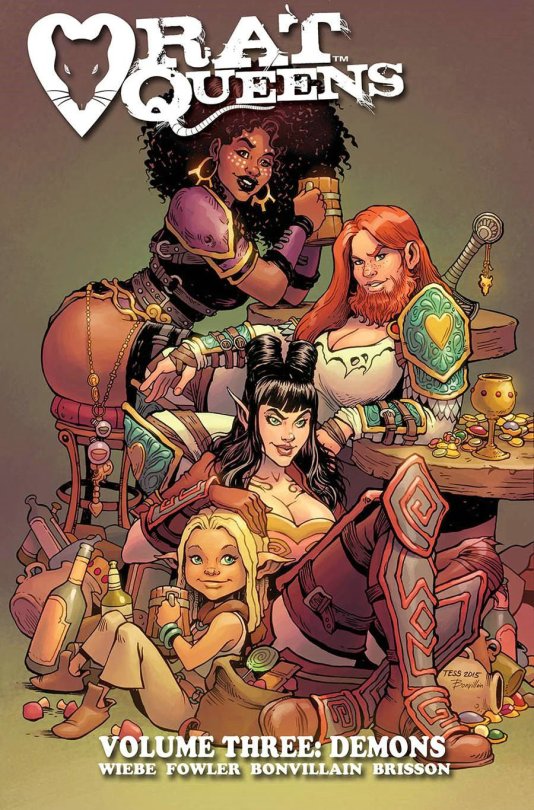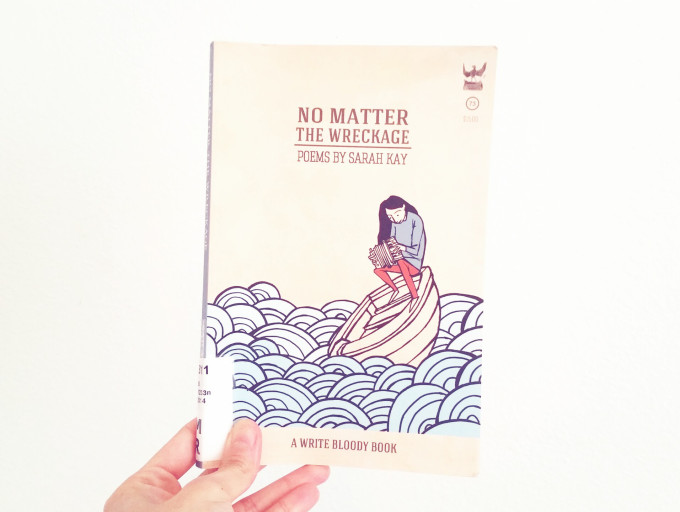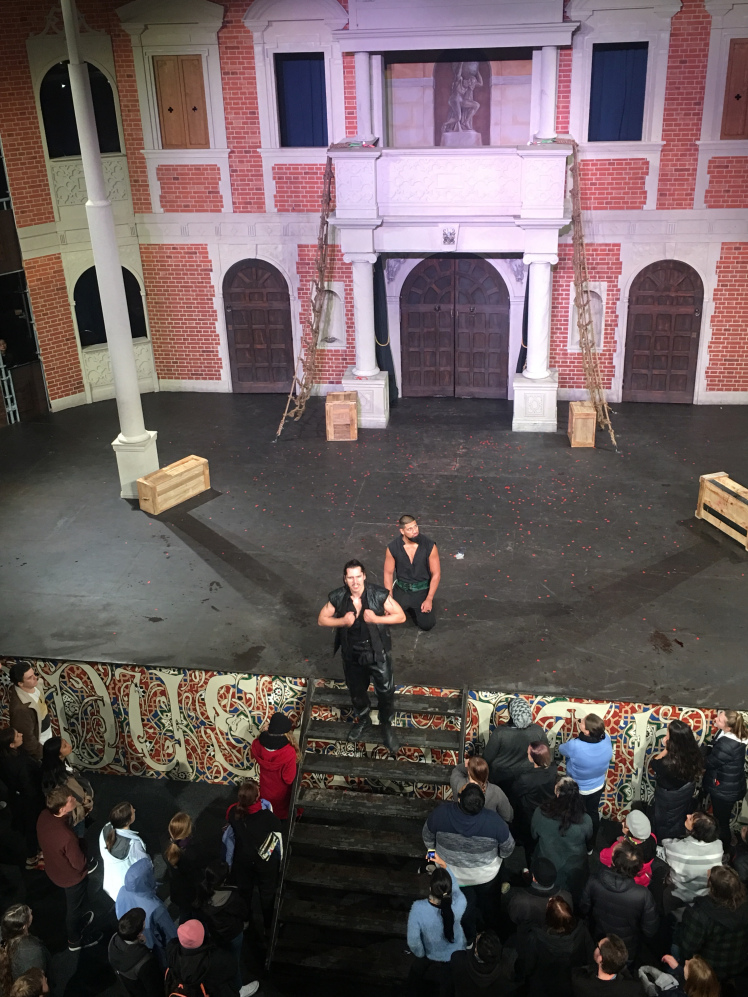When it comes to colorful art, Yayoi Kusama pretty much obliterated 2017. People flocked to her travelling exhibitions, queued hours to spend 30 seconds in her mirrored infinity rooms and used her bright patterned artworks and polka dots to take awesome selfies and be happy. Quite an awesome accomplishment for art that is produced as the only way Kusama found to resist suicide and survive the hallucinations that have plagued her life since being a young girl. “With no distinction between her as an artist and the product of her art, this is the intensity we can’t help but feel striking us all” was how I described it in my blog last year.
Another artist who produced what we perceive as colorful art but which is in fact a form of therapy to alleviate darker life events is French-born Niki de Saint Phalle. Her Coming Together sums it up for me.
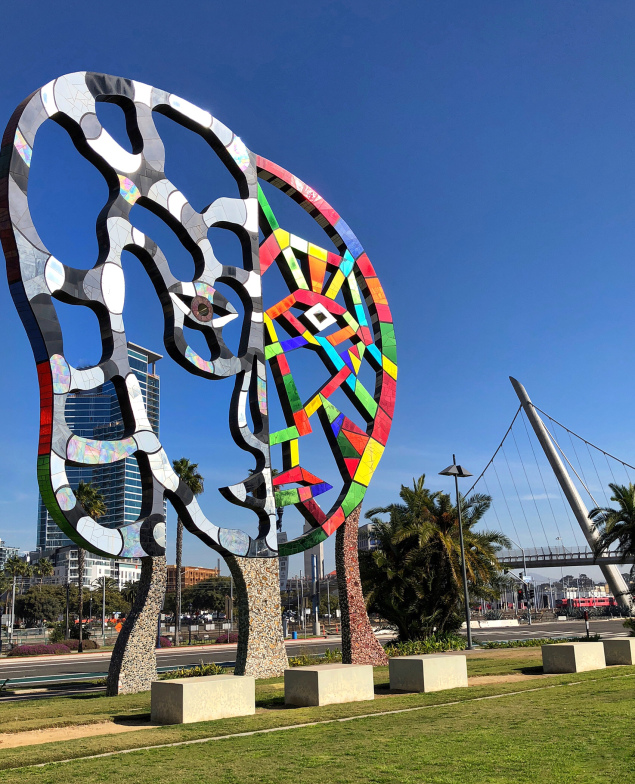 Niki de Saint Phalle, Coming Together (2001), San Diego
Niki de Saint Phalle, Coming Together (2001), San Diego
A two-faced flat sculpture, it is half man / half woman, neatly contrasting black and white mosaic with touches of iridescence on the female side with bright primary – but overall flat – colors on the male side.
Associated with New Realism, her larger than life sculptures and drawn figures are joyously colorful.
 Niki de Saint Phalle, Angel of Temperance (1998), Mingei International Museum, San Diego
Niki de Saint Phalle, Angel of Temperance (1998), Mingei International Museum, San Diego
They celebrate the curvaceous, the voluptuous shape of the female body. In the 1960’s, they hereby liberated viewers from complexes imbued by a then very patriarchal society. Nowadays, has anything changed? Well, #TimesUp at least.. but our society has also gone bingeing on a low truth diet of information where media too often distort the shape and form of what is considered beautiful. This makes Saint Phalle’s art more relevant, not less.
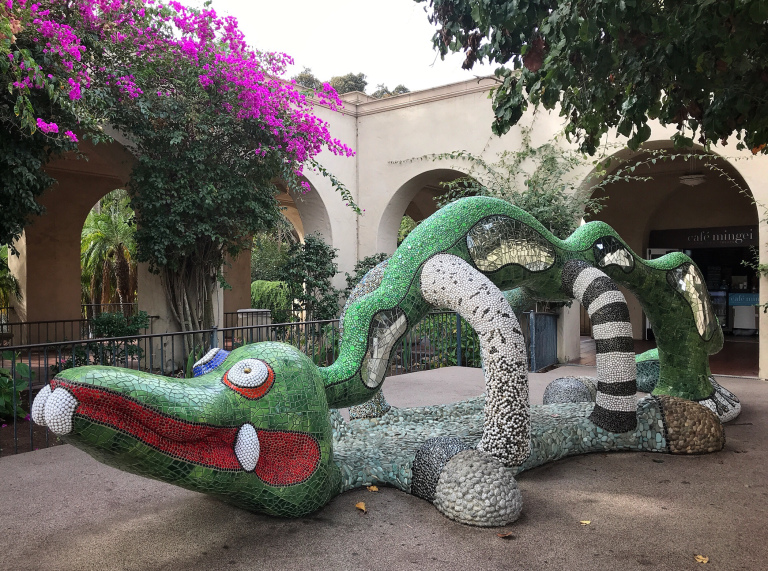 Niki de Saint Phalle, Nikigator (2001), Mingei International Museum, San Diego
Niki de Saint Phalle, Nikigator (2001), Mingei International Museum, San Diego
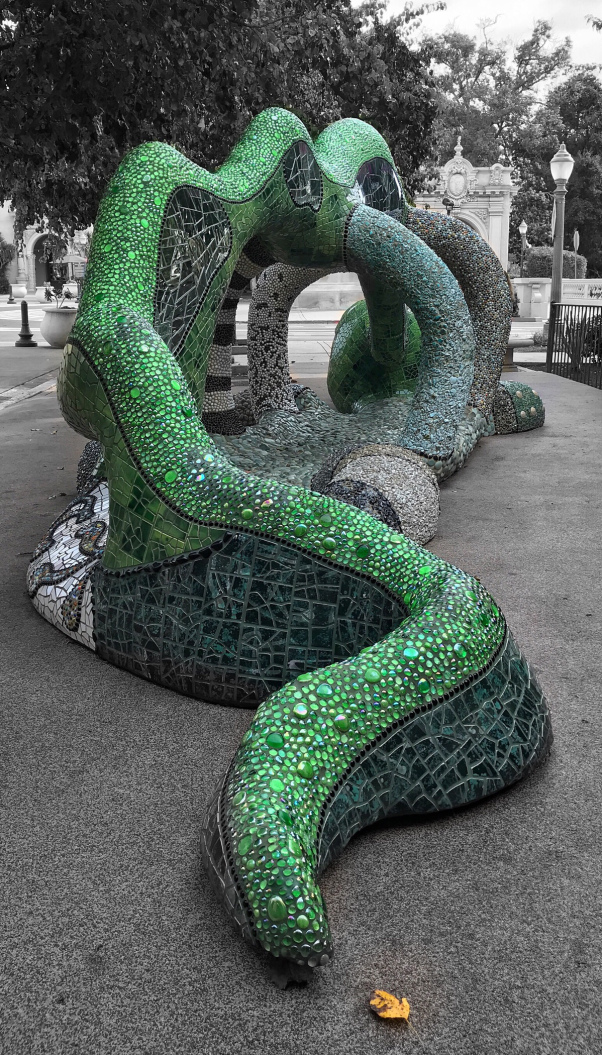 Niki de Saint Phalle, Nikigator (2001), Mingei International Museum, San Diego
Niki de Saint Phalle, Nikigator (2001), Mingei International Museum, San Diego
All the more as her elated creations are often found in playgrounds, where children adore her carnivalesque creations covered in glittering mosaic works.
I remember I discovered the art of Niki de Saint Phalle on two distinct occasions. A trip to Paris when I was young got me marvelling at the Stravinsky Fountain, designed by French-born Niki de Saint Phalle with her second husband, Swiss artist Jean Tinguely. Then later on, I stumbled on a Madame Pomme de Terre lithograph owned by a dear friend of mine.
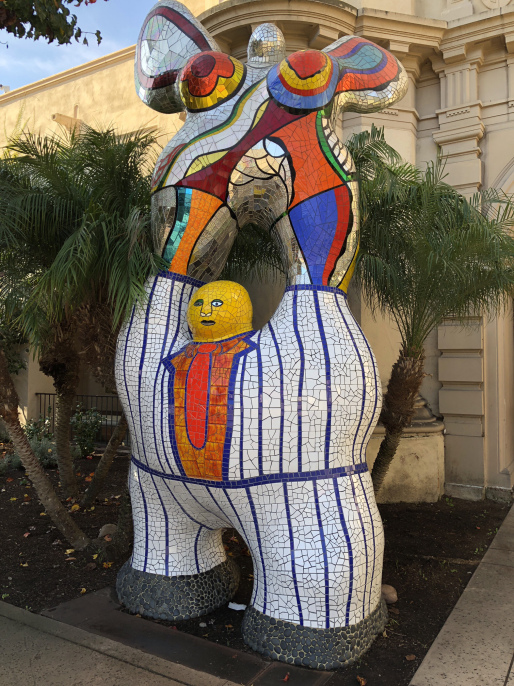 Niki de Saint Phalle, The Poet and his Muse (1998), Mingei International Museum, San Diego
Niki de Saint Phalle, The Poet and his Muse (1998), Mingei International Museum, San Diego
Each time, an exuberance of colors and fullness of forms provided for an exhilarating experience.
When I moved to San Diego almost 7 years ago, I could not believe my eyes upon seeing MANY Niki de Saint Phalle’s works here, including one of her larger projects, Queen Califia’s Magical Circle. How come?
 Niki de Saint Phalle, Queen Califia’s Magical Circle (2002), Kit Carson Park, Escondido
Niki de Saint Phalle, Queen Califia’s Magical Circle (2002), Kit Carson Park, Escondido
As the story goes, Niki de Saint Phalle was born an aristocratic beauty. She modelled for Vogue and Life magazines. Yet at age 23, she suffered a nervous breakdown, soon after marrying her first husband, American writer Harry Mathews.
Unbeknownst at the time but probably hugely influential on her psychological state, she had been abused by her father since the age of 11. Yet she would only reveal this traumatic life event when, at age 62, she published her book called Le Secret.
Much like Yayoi Kusama, she found that dedicating her life to making art helped her emotional state of mind. Self-taught, she became a full-time artist and sculptor who would never tire of criticizing High Art, Family and the Church¹ – which comes as no surprise once you know about her life traumas.
Like Kusama, Niki de Saint Phalle chose colors to express and vanquish her demons. Some of her best known works are the Nanas.
 Niki de Saint Phalle, Miss Black Power (1968), Hakone Open Air Museum, Japan
Niki de Saint Phalle, Miss Black Power (1968), Hakone Open Air Museum, Japan
 Niki de Saint Phalle, Miss Black Power (1968), Hakone Open Air Museum, Japan with Antony Gormley, Close (1993) on the ground.
Niki de Saint Phalle, Miss Black Power (1968), Hakone Open Air Museum, Japan with Antony Gormley, Close (1993) on the ground.
“She was missing heroines and role models as a kid so she decided to make some for herself” declares her granddaughter Bloum Cardenas.
Niki created her Nanas larger than life, in retrospect certainly to dwarf men and their powers. But first and foremost, the Nanas flaunt their curves, their sensuality, their audacity.
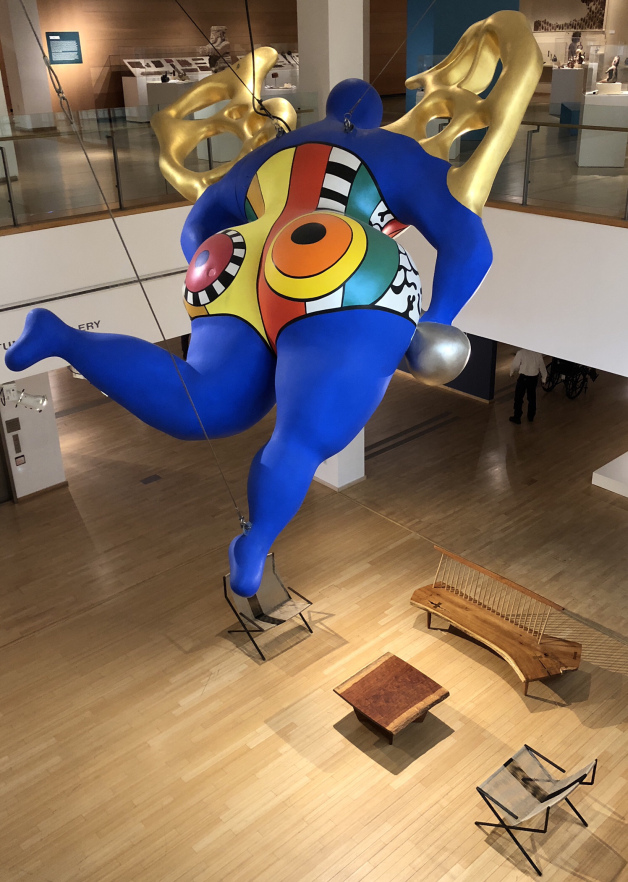 Niki de Saint Phalle, Angel of Temperance (1998), Mingei International Museum, San Diego
Niki de Saint Phalle, Angel of Temperance (1998), Mingei International Museum, San Diego
They are feminist, telling it bright and loud, flaunting their large breasts and posteriors painted as unmistakable targets.
Niki de Saint Phalle fabricated her Nanas using new materials at the time, including composite fiberglass-reinforced polyester plastic and polyurethane foam. This immediately granted them a unique and naive papier mâché style, almost piñata-like² appearance. Yet it would also a lethal impact on her life…
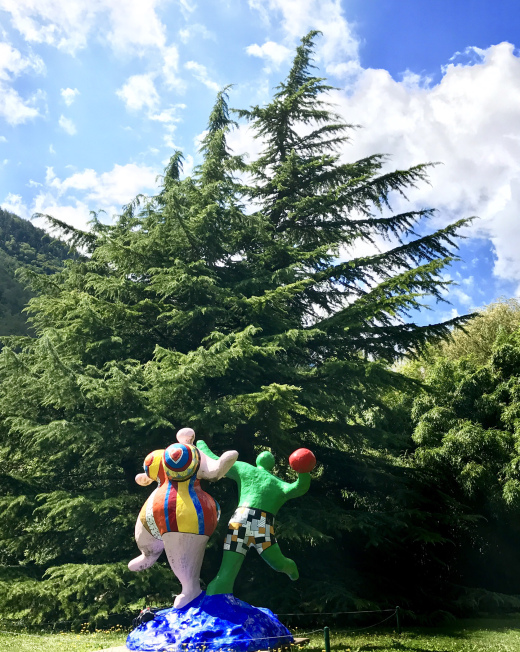 Niki de Saint Phalle, Les Baigneurs (1984), Fondation Gianadda, Martigny
Niki de Saint Phalle, Les Baigneurs (1984), Fondation Gianadda, Martigny
Painted brightly, these monumental sculptures exercize a magnetic appeal. Back in 1966, people flocked to the Moderna Museet of Stockholm to enter HON through her gigantic vagina / door while today, delighted viewers keep entering Nana-Maison II at La Monnaie de Paris. An entire essay would be required to unravel how cheekily playful this was on Niki’s part and how brilliantly she was making her feminist points through her art.
In the process, her colorful art appeared accessible and reached a wide audience, including kids (and some adults) who happily don’t want to see such darker undertone. Niki de Saint Phalle soon became a “grandmother figure to all children”³.
Well connected in the world, she managed to impose her works on a global basis, with commissions well beyond France and Switzerland.
Yet her health was frail all her life. Plagued by rheumatoid arthritis (RA), she was later diagnosed with pulmonary disorders caused by toxic fumes and glass fibers from polyester and polysterene used in her Nanas sculptures.
It is during a trip to San Diego meant to discuss her major retrospective at the Mingei Museum that founder (and friend) Martha Longenecker convinced Niki of the health benefits the Californian climate could bring her. Niki de Saint Phalle moved to La Jolla in 1994 where she stayed until her death in 2002.
And that’s why I am lucky to see so much of her art out and about.
 Niki de Saint Phalle, Sun God (1983), UCSD Campus, San Diego
Niki de Saint Phalle, Sun God (1983), UCSD Campus, San Diego
Some sculptures like Sun God (1983), she brought well before moving to San Diego.
Others are gracing playgrounds and public places throughout the San Diego County because she never stopped creating in spite of her health conditions.
In each of her creations, you can choose to rejoice in her mood-lifting palette of colors achieved via an incredible array of tumbled rocks and glass mosaics ranging from matt, iridescent, mottled, textured, round as cabochons or jagged as shards.
For me though, each piece has a totemic quality I can’t quite shake off.
It is ever so clear in Queen Califia’s Magical Circle which Niki de Saint Phalle spent years developing but unfortunately never saw completed in full.
In the process, she bequeathed a fantastical place where children and adults alike can let their imagination run wild under a sparkling starry sky.
Where playing hide and seek amidst mosaic creatures of all kind allows people to rejoice in all the colors the spectrum has to offer.
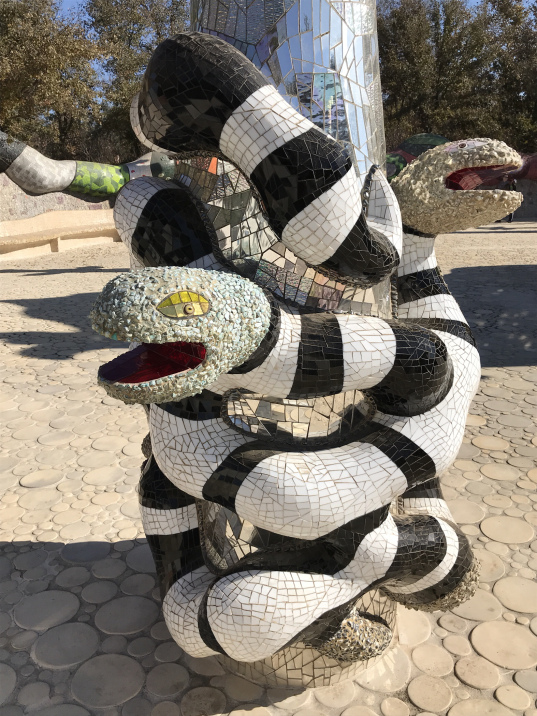 Niki de Saint Phalle, Queen Califia’s Magical Circle (2002), Kit Carson Park, Escondido
Niki de Saint Phalle, Queen Califia’s Magical Circle (2002), Kit Carson Park, Escondido
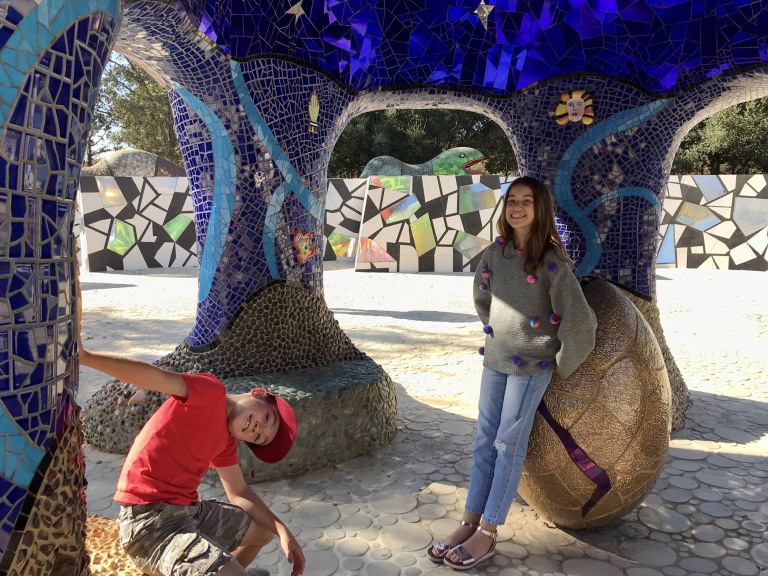 Niki de Saint Phalle, Queen Califia’s Magical Circle (2002), Kit Carson Park, Escondido
Niki de Saint Phalle, Queen Califia’s Magical Circle (2002), Kit Carson Park, Escondido
 Niki de Saint Phalle, Queen Califia’s Magical Circle (2002), Kit Carson Park, Escondido
Niki de Saint Phalle, Queen Califia’s Magical Circle (2002), Kit Carson Park, Escondido
 Niki de Saint Phalle, Queen Califia’s Magical Circle (2002), Kit Carson Park, Escondido
Niki de Saint Phalle, Queen Califia’s Magical Circle (2002), Kit Carson Park, Escondido
 Niki de Saint Phalle, Queen Califia’s Magical Circle (2002), Kit Carson Park, Escondido
Niki de Saint Phalle, Queen Califia’s Magical Circle (2002), Kit Carson Park, Escondido
Much like her Tarot Garden in Tuscany, this large scale project was Niki de Saint Phalle’s own art therapy, her own voodoo maze to exorcize the demons of her childhood.
Therapeutic mosaic works and pure energy from colors helped her lift her mind clouds. It never failed to do so for my family too, year after year.
 Niki de Saint Phalle, Queen Califia’s Magical Circle (2002), Kit Carson Park, Escondido
Niki de Saint Phalle, Queen Califia’s Magical Circle (2002), Kit Carson Park, Escondido
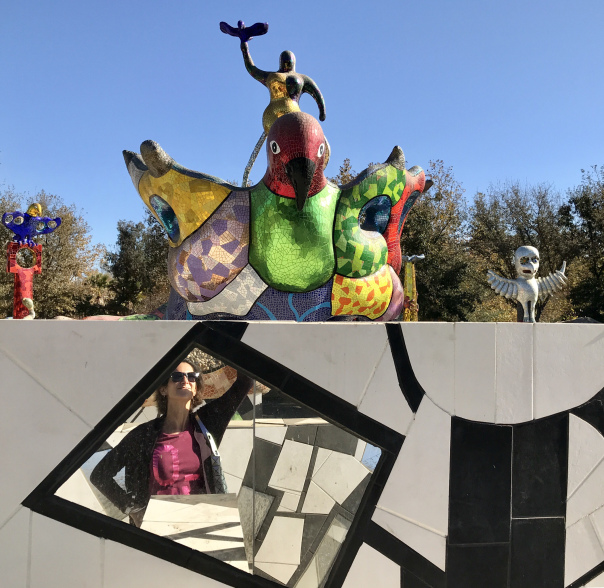 Niki de Saint Phalle, Queen Califia’s Magical Circle (2002), Kit Carson Park, Escondido
Niki de Saint Phalle, Queen Califia’s Magical Circle (2002), Kit Carson Park, Escondido
 Niki de Saint Phalle, Queen Califia’s Magical Circle (2002), Kit Carson Park, Escondido
Niki de Saint Phalle, Queen Califia’s Magical Circle (2002), Kit Carson Park, Escondido
For preservation and restoration reasons, you can only visit Queen Califia’s Magical Circle on specific days. Please check this link for more info.
An exhibition celebrating Niki de Saint Phalle and the 15th anniversary of Queen Califia’s Magic Circle will be held at the Escondido California Center for the Arts from January 13, 2018 until March 4, 2018.
© 2018 Ingrid Westlake
All pictures by Ingrid Westlake, unless otherwise stated.
Follow Blog via Email
Enter your email address to follow this blog and receive notifications of new posts by email.
¹ Eunice Lipton, The Darkness Behind Niki de Saint Phalle’s Colorful Beauties, Hyperallergic, January 26, 2015
² Ken Johnson, Niki de Saint Phalle, Sculptor, is Dead at 71, New York Times article, May 23, 2002
³ Madeleine Morley, Niki de Saint Phalle: A Retrospective and a Rediscovery, Port Magazine, March 11, 2015
Advertisements Share this:

